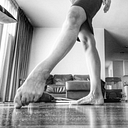Ballet dictionary for adults. How to do a demi-plie.

Welcome to the first Ballet Dictionary episode. “Ballet Dictionary for adults” is a project where I give thorough explanation of basic ballet movements with tips and tricks specifically for adult ballerinas. I also give links to useful videos from the ballet teachers that I trust.
In this session I will talk about how to do a demi-plié.
In my explanations I go by the legendary book “Basic principals of classical ballet” by Vaganova. Lifehacks for adults are purely my own (I’ve been doing ballet for 11 years in total) observations and experience. I only give the tips that actually did work for me.
What is a demi-plié?
Plié — is a knee bent in French. Demi-plié — half a knee bent. Grand plié — big knee bent.
Fun fact: Vaganova says that you actually “need to study grand-plié only after your demi-plié is perfect”. I’ve never seen any teacher follow this logics for adult students (and I’ve tried many teachers). In any case, it’s useful to know that actually your grand plié beauty depends for the biggest part on how well you’re managing your demi-plié.
Why do you need to do so many pliés
A plié has a crucial role in ballet: it is a part of almost every exercise we do at the barre and in the middle. Vaganova says that a strong skill of plié turns your performance into actual ballet, and not just a set of movements.
If a dancer lacks plié, her performance is dry, coarse and devoid of plasticity. © Vaganova.
Demi-plié rules from Vaganova
- The weight is evenly distributed not only on both legs, but also on both feet, without putting too much weight on the front of your foot.
- Leave your heels on the floor. This is crucial: when your heel stays on the floor, your Achilles tendons are developing.
- It is crucial to open your knees well, i. e. to make sure the turnout is done from the hips. Control the upper part of your legs, from your hips to your knees. Your knees need to open in the direction of your toes.

Tips for adults
1. Do not lose your posture. Go down until you are able to to keep your posture correctly, even if in this case your demi-plié is not deep at all. If you feel like your pelvis is starting to go a bit backwards (this happens a lot with adults), it’s a sign that you’re going too deep and losing your posture.
2. How does a correct demi-plié feel? That’s how: heels press hard on the floor and your spine is “aspiring upwards”, as if trying to reach the sky. I personally have the sensation that I push the floor with my heels as hard as I can.
3. In the first position (you start learning demi-plié from the first position) your feet should stand freely, because their main goal is to keep you stable.
4. Your knees should “look” (should be turned in the direction of) at your toes. Do not try to force your feet make a straight line in the first position, while your knees can hardly open — this is an easy way to injuries. Make sure your knees and your toes are on the same tune here. In this way you will progress faster.
5. The turnout starts with your hips, not with your feet. During a plié, its your hips that open, you’re not just opening your knees. You should feel as if somebody took your hips in their hands and is trying to rotate them backwards. At first it always feels unnatural. But after many classes and repetitions you will vet used to it and will never be able to do otherwise.
This approach will help you develop good hips turnout (it’s also called upper turnout), which is a foundation of your stability in all the exercises.
6. Your pelvis should be right in the middle, not slightly forward or backward. The most frequent thing that happens with adults is when your pelvis goes either a bit backwards or too much tucked in during a plié. Try to make it stay right in the middle and open your hips from this position.
7. Don’t put too much weight on the inner side of your feet. It’s not easy to keep your weight distributed on all your feet during a plié, but it should be your goal. Let your plie be not too deep, let your feet stand freely, but make sure you stand strong on both of your feet, without putting too much weight on their inner side.
One of my teachers used to check stability during a plié in the following way: he asked to let go of the barre and gave a slight (but firm) push with his finger on the shoulder of a student: to see if a student will keep stable and strong or will slightly move and lose the position. You won’t believe it but most students did not pass the test and moved after the push:). Yep, a plié is by far not an easy thing to perform correctly.
In the short video (2 min) below Ilya Kuznetsov — an adult ballet teacher in Dance Secret studio in Moscow, Russia — shares 6 rules of a correct demi-plié and gives an interesting tip on how to check yourself if you’re doing in right. The video has English subs.
Author — Evgenia Budrina. I am a dance enthusiast from Russia.
I started doing ballet at 32. In my blog I write about and for those who started dancing as adults and take it seriously. Personal stories, failures, life-hacks and thoughts.
My Instagram — @_a.dancer_
